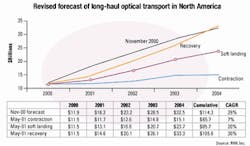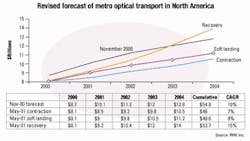Network utilization with an eye toward future technology
Optimism is replaced by caution in network deployments, but not in all market segments.
BY WINN HARDIN
As telecommunications analysts and carriers rework their growth expectations for 2001 based on the current economic slump, technology expansion of metropolitan-area networks appears even more attractive this year compared to long-haul deployments.
Fred Harris, vice president of research, architecture, and design at Sprint (Overland, KS), acknowledges that today's economic conditions have caused the long-distance carrier to make some "corrections, but not major changes in our direction."
"We're going as fast as we can on MAN build-out," says Harris. "We have cut back slightly on deployment in the long-haul network. If you start out by expecting a certain amount of demand, and that demand decreases, you don't have to build as fast. We want to stay ahead of the [long-haul] curve, but we don't want to get too far out in front. Several months ago, we announced some cutbacks on capital spending, but fairly minor cutbacks."Sprint's strategy is in line with analysts' reports on the market. "Over the last two years, an enormous amount of capacity, far in excess of actual demand, has been added to long-haul networks by both major and startup carriers," observes Mark Storm, optical-networking program leader at market researcher Frost and Sullivan. "It will take between 12 and 18 months to find paying customers to utilize the high-cost equipment that's already installed, even though bandwidth demand continues its robust growth. So carriers are deferring network building and trying to optimize the equipment systems they have."
"In the short-to-intermediate term," says Rob MacLellan, director of market researcher RHK Inc.'s telecom economics group, "the long-haul market for optical gear is looking at a serious slowdown compared to last year. The expectation is that metro optical is going to be the next [high-growth] area...uncorking the massive amounts of capacity installed in the long-haul market. There's no point in planning to haul X terabits from New York to Chicago if you can't get it out of New York or into Chicago easily. However, the rate at which metro deployment takes place is completely at the mercy of the decision [rates], capital spending abilities, and desires of primarily the established carriers."RHK's most recent projections show CAGR for optical transport in North America through 2004 in the long-haul-network segment dropping from 29% to 20%, with 2002 showing an upswing based on deferred purchases for optical core switches and ultra-long-haul equipment currently under evaluation (see Figure 1). RHK revised its MAN optical transport forecast in North America from 10% to 8% for the same period, noting strong price pressures on OC-48 add/drop multiplexing equipment (see Figure 2). The MAN expansion owes much of its growth to the outsourcing of enterprise data services, according to Brian Van Steen, RHK senior analyst.
In the metro market, Sprint expects its bundled broadband services accessed through the ION platform and its deployment of data centers to provide the differentiating value-added services that are the hallmark of a successful business plan. To date, the ION network serves about 3,300 customers.
"We're running ION under an all-ATM core network, and we'll continue down that road until IP is robust enough to provide the reliability and quality of service to exist independently," says Harris. "We're rapidly exploring the move to IP...[but] routers are not typically carrier-class equipment, because they were designed for machine-to-machine communications." When latency management, reliability, and other quality-of-service issues are resolved, the systems will handle voice as well as they handle data today, according to Harris, and Sprint will make the move.
While Sprint's core strategy might not have changed, it has expanded to include opportunities in build versus buy to acquire additional bandwidth. "We're evaluating what is the best way to move forward," says Harris. "We think that companies like Level 3, Williams Communications, and others are refocusing on their original business purpose. We're looking at [their infrastructures] as a way to complement what we're doing. The right solution is the one that makes the best sense for the company, whether we lease it from someone else or build it ourselves."
Like Sprint, nationwide carrier Verizon (New York, NY) invested heavily in network expansion over the last year. Now, the carrier is focusing on upgrading its existing network rather than wholeheartedly pursuing expansion. "We put a lot of infrastructure in last year and the first quarter of this year in anticipation of aggressive growth," says Chuck Dunsey, vice president of network engineering at Verizon. "That's slowed a little because of the CLECs [competitive local-exchange carriers] that are now in financial trouble. We're using the bandwidth we have now to continue satisfying our growth. That allows us to also retire some of the asynchronous equipment we have today." Verizon is also evaluating leasing bandwidth from wholesale carriers such as Level 3 Communications (Broomfield, CO) and Metromedia Fiber Network (MFN-White Plains, NY).
On the technology side, Verizon is continuing to upgrade its existing network by implementing DWDM and next-generation OC-48 and OC-192 systems. The carrier has even considered purchasing equipment from some hard-hit CLECs. "Former competitors are seeking to do business with us," says Dunsey.
Next year, the carrier plans to pursue the ring-based DWDM and OC-768 systems after equipment evaluation. "These next-generation systems give us a smaller footprint, which is something we desperately need. Space and power are some of the most important considerations. The new systems can use up to three times the amount of power, but only use one-third of the space...The new technologies outstrip the HVAC [power] capabilities within the facilities."
The carrier is also planning to expand its Gigabit Ethernet and fiber connection services to regional customers within the next year.
Preparation for the all-optical network is another area of expansion. "Our focus has been on installing optical interfaces and the supporting management system behind it," says Dunsey. "The age of electrical handoffs has far outstripped its usefulness...Once we convert to light, that is where we'd like to keep it. That brings us to optical switches, which are critical because that provides a lot of the operational savings." Verizon has even taken to changing out miles of coaxial cable that make up very short runs between floors. "The optical switches aren't there, but when they do become available, we want to be able to plug them in and go."
Smaller MAN service providers such as Looking Glass Networks (Oak Brook, IL) are also approaching the market with caution. Looking Glass, which plans to have data transport networks in nine U.S. cities by the end of 2001, has targeted the network edge since its inception last year. The company's success relies on laying fat pipes between carrier locations-incumbent local-exchange carriers, central offices, Internet service providers-to large enterprise-class customers. The company expects to have a collocation presence in 210 buildings in 2002.
Looking Glass owns its own fiber, and its business model is different from providers of dark fiber. "We lay fiber with the primary intention of lighting it to provide services," says Ketan Patel, director of product development and marketing at Looking Glass. "In the past, we had assumed a certain amount of enterprise traffic on our network. But with the fall of the dot-coms and some CLECs, we are waiting for initial interest from the customer before we go into the building. Some of these carriers are fighting for capital or ways to bridge the gap between spending and funding plans. We are waiting for [customers] so we're not exposed to 100% of that risk.
Despite its cautious approach, Looking Glass issued an RFP for next-generation equipment in July 2000 and finally settled on Cisco Systems' 15454 optical transport platform in February. "This equipment is very dense, so we can drive a lot of customer ports from a single chassis. It uses less power and less real estate," says Patel. "It doesn't require the headend gear that traditional SONET networks do. We can do SONET as well as optical Ethernet, wavelength, Fibre Channel, and storage-area transport."
According to Patel, demand in the metro market is still doubling each year. "There is some slack in the long-haul, but in the metro market, a lot of these applications are local and more people are cashing in on the content for the metro markets. We believe the demand in the metro area will continue to be strong," he says.
Winn Hardin is a freelance technology writer living and working in Neptune Beach, FL. He can be reached at [email protected].


